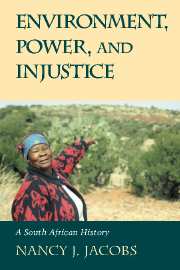Book contents
- Frontmatter
- Contents
- List of Illustrations
- List of Tables
- Preface
- Abbreviations
- 1 Approaching Kuruman
- 2 Goat People and Fish People on the Agro-Pastoral Frontier, c. 1750–1830
- 3 Intensification and Social Innovation on the Cape Frontier, 1820s–1884
- 4 Colonial Annexation: Land Alienation and Environmental Administration, 1884–1894
- 5 Environmental Trauma, Colonial Rule, and the Failure of Extensive Food Production, 1895–1903
- 6 The Environmental History of a “Labor Reservoir,” 1903–1970s
- 7 Apportioning Water, Dividing Land: Segregation, 1910–1977
- 8 Betterment and the Bophuthatswana Donkey Massacre: The Environmental Rights of Tribal Subjects, 1940s–1983
- 9 Retrospectives on Socio-Environmental History and Socio-Environmental Justice
- Appendix A South African Census Statistics on Human Population
- Appendix B South African Census Statistics on Stock Population
- Appendix C1 1991 Individual Interviews
- Appendix C2 1997–1998 Individual Interviews
- Appendix C3 1991 and 1997–1998 Group Interviews
- Appendix D A Note on Archival Sources
- Notes
- Index
7 - Apportioning Water, Dividing Land: Segregation, 1910–1977
Published online by Cambridge University Press: 05 July 2009
- Frontmatter
- Contents
- List of Illustrations
- List of Tables
- Preface
- Abbreviations
- 1 Approaching Kuruman
- 2 Goat People and Fish People on the Agro-Pastoral Frontier, c. 1750–1830
- 3 Intensification and Social Innovation on the Cape Frontier, 1820s–1884
- 4 Colonial Annexation: Land Alienation and Environmental Administration, 1884–1894
- 5 Environmental Trauma, Colonial Rule, and the Failure of Extensive Food Production, 1895–1903
- 6 The Environmental History of a “Labor Reservoir,” 1903–1970s
- 7 Apportioning Water, Dividing Land: Segregation, 1910–1977
- 8 Betterment and the Bophuthatswana Donkey Massacre: The Environmental Rights of Tribal Subjects, 1940s–1983
- 9 Retrospectives on Socio-Environmental History and Socio-Environmental Justice
- Appendix A South African Census Statistics on Human Population
- Appendix B South African Census Statistics on Stock Population
- Appendix C1 1991 Individual Interviews
- Appendix C2 1997–1998 Individual Interviews
- Appendix C3 1991 and 1997–1998 Group Interviews
- Appendix D A Note on Archival Sources
- Notes
- Index
Summary
Into this area where people are quite literally dying of starvation, and where T.B., scurvy and all forms of malnutrition are rife, thousands more people have been and still are to be moved for the sake of tidying up the map.
In 1910, a new country, the Union of South Africa, was created with four provinces: the former British colonies of the Cape and Natal and the former Boer republics of the Orange Free State and South African Republic. An inchoate principle of segregation underlay Union governance at the beginning, and over the next four decades it developed into more sharply defined and extreme policies. After the formation of the Union, successive generations of segregationist policy increasingly determined how people related to each other, the state, the economy, and the environment, although the last point is not often recognized. The environmental dynamic is evident in many aspects of the history of racial segregation. Because segregated spaces are lived-in environments where certain uses are possible but others are difficult, segregationists considered the quality of the environment and its potential uses when they allocated territory between races. Not just the quality of the environment, but existing uses came into consideration, and the fact that African land use was extensive made confiscation of choice lands and water supplies easier. Moreover, the outcome of segregation was environmental. Removals and resettlements forced people to adapt to different environments, and these adjustments exacted a high price from the victims.
- Type
- Chapter
- Information
- Environment, Power, and InjusticeA South African History, pp. 148 - 172Publisher: Cambridge University PressPrint publication year: 2003

